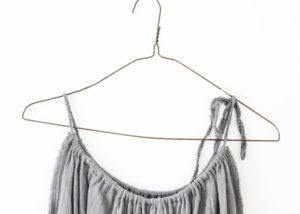I’ve sold used furniture, and even cars, to strangers before. But as anyone who’s done this will tell you, the return is rarely worth the effort. Posting photos to an online community populated by strangers, dealing with hard bargainers and delivering the goods doesn’t make sense for anything under $50. And since taxpayers in the US get a break for charitable contributions, donating extra items is often easier and more lucrative.
 But recently, I’ve been hearing stories about stay-at-home moms who make a fantastic living — $40,000 or more per year — selling clothes online. Not all of these garments are ones they purchased, either. Many are fetched from thrift stores or estate sales.
But recently, I’ve been hearing stories about stay-at-home moms who make a fantastic living — $40,000 or more per year — selling clothes online. Not all of these garments are ones they purchased, either. Many are fetched from thrift stores or estate sales.
Because I’m petite and fashionably open-minded, I’m often the recipient of friends’ high-end secondhand apparel. And occasionally I get high-end designer duds: a fancy pair of suede stiletto heels or a trendy bikini by a hot California label.
Recently, a good friend of mine decided an $800 silk dress no longer fit her and would look better on me. I was thrilled — until I realized that the sleeves of the dress were too puffy and not really my “style.” I knew sites like Tradesy, Poshmark and Threadup cater to women who want designer clothes for less and are open to gently worn garments.
So thinking about what Dr. Tony Pennells, founding director of MindShift.money, says, “Always be on the lookout for opportunities to earn, and add as much as possible to your financial surplus. You’ll reach Financial Freedom that much more quickly,” I decided to give selling clothes online a try.
Getting Started Selling Clothes Online
Since I’d never sold anything direct-to-consumer online before — whereupon someone “orders” an item from me, and I ship directly to them, without them having seen or touched said item — I had my research cut out for me.
 After using the Internet to search for advice on how to sell clothes and get the highest dollar value, I learned a few things:
After using the Internet to search for advice on how to sell clothes and get the highest dollar value, I learned a few things:
- Photos are king: People like to see a lot of crisp, clear photos of garments that show detail. Even better is putting them on hangers or mannequins atop a plain, solid background (e.g., a white wall).
- Details are crucial: The more descriptive you are in a post, the more likely you’ll get traction. No one wants to buy a “black dress” without knowing the brand, size or material blend. They also want clear indicators the garment is in decent condition or is listed appropriately (e.g., gently used, new with tags, etc.)
- Patience is key: Pricing is tricky. It goes without saying that the less expensive something is, the faster it will sell. But while you can aways price an item lower, if demand isn’t high, it’s hard to mark it up once you go down.
I decided to use Tradesy to try to sell my dress. The company takes less than 3 percent of earnings and has tools to help sellers promote their wares. After researching similar dresses, I used the site’s built-in pricing algorithm to set the price at $160. This was lower than I’d hoped, but I wanted to sell the dress as quickly as possible.
The Verdict
My dress “sold” about one week later. Great, right? Yes, but my seller insisted I overnight the package to accommodate her upcoming 5-week trip away from home.
I grudgingly obliged, although overnight shipping cost $35, and would eat into my profits. I was afraid the dress wouldn’t sell any other way, or at least not as quickly.
 But now, I’m a little nervous. The dress sold two weeks ago, but I’ve yet to see the money melt into my account. Apparently I should be willing to wait up to three weeks, but my dress’ absence and the lack of money is making me anxious.
But now, I’m a little nervous. The dress sold two weeks ago, but I’ve yet to see the money melt into my account. Apparently I should be willing to wait up to three weeks, but my dress’ absence and the lack of money is making me anxious.
I can’t help but wonder, ‘did I do something wrong?’ or if I’ve been scammed. Now I wish I’d waited it out for a less-frantic buyer.
There’s no point in having a super-expensive dress I’m not in love with. But I know now I’m not cut out for the world of selling clothes online.
So next time I’m sick of an item of clothing, I’ll probably just give it to Goodwill. The most precious thing that money can buy is time.
Again remembering what Dr. Tony says, “Regardless of a goal to increase income, I wouldn’t encourage you to dramatically change your lifestyle. Time for family, friends,
and holidays is important, too!”
So every second I’m trying to peddle apparel online is a second I’m not engaging in my primary, and more lucrative, vocations: writing and guitar teaching. Both are immensely more enjoyable than selling clothes and offer decent pay in exchange for my precious personal minutes.
The views and opinions expressed are those of the guest author and do not necessarily reflect the views and opinions of MindShift.money.
image credit: Bigstock/88studio
Marisa Torrieri is an award-winning journalist and freelance writer specializing in personal finance, business, healthcare and technology. She has a master’s degree in journalism from Northwestern University and resides in Fairfield, CT. Her work has appeared in dozens of media outlets, including LearnVest, Forbes, The Washington Post, Business Insider, TIME and Health.com.
